إجمالي مرات مشاهدة الصفحة
السبت، 23 أبريل 2011
الأربعاء، 6 أبريل 2011
الثلاثاء، 5 أبريل 2011
Learn something to Save Your Life
te
Learn something
to Save Your Life & that of others…
Know About Snakebite – How to Avoid Getting Bitten – First Aid & Treatment – How NOT to Treat Snakebite – About Venom – About Antivenom Serum
KNOW ABOUT SNAKEBITE
Total ignorance prevails about snakes and snakebite in India and because of the deep-rooted superstitions many precious lives are lost and snakes are hounded and killed. About 25,000 people reportedly die of snakebite in India every year (However, the unreported cases may be even more), mostly in rural India; yet there is no organised effort to cope with the emergencies arising out of snakebites, especially in rural India.
There are two important aspects of snakebite management, one is the first-aid, basically management of snakebite victim, and then the timely medical treatment by experts (antivenom serum therapy). Since rural people have to rush to nearby towns and cities to get medical support, precious time is lost in organising transport and travelling. If one could understand about snakes, prevention of snakebite, the proper first-aid and transportation to the proper medical facility, the fatalities due to snakebites could be reduced effectively.
In absence of any authentic information about snakes & snakebite for common man to deal with snakebite emergencies in India, there are many myths about snakes and snakebite. The snake charmers and feature films with their vested interests, have been adding fuel to the fire with misleading stories about snakes and snakebite. As a result, people have more trust on false claims of treatment and most of the times people fall prey to quacks’ treatment. Part of the problem when someone is bitten, is the element of surprise, as people are usually not aware or trained to deal with a snakebite emergency. Preparation, which includes knowing in advance about the basic knowledge about snakebite management and how to get to the nearest hospital– could greatly reduce anxiety and lead to more effective care. The best solution is to educate people – disseminate information about snakes and snakebite – what are snakes, where, when and why do they bite, how to avoid getting bitten, what to do when bitten, etc. It helps to understand that:
- All snakes are not venomous – so every snakebite is not going to result in death – it would save people from quacks. And reduce the amount of panic and chaos.
- Even a venomous bite is not always fatal – because the severity of snakebite depends on many factors like the size of the snake, whether the bite could be completed, whether it was a dry-bite or not, the age, physique and affected limb of the victim.
- First Aid would enable a person to buy more time to reach effective medical aid, on time.
- The only cure for the snakebite, which is available is anti-venom serum injection and not quacks.
- First Aid – if not done properly could cause more harm than benefit. So, it has to be explained with demonstration.
- Save the rural innocent/simple people from snake-charmers and quacks.
PREVENTION is better than Cure !
Best is to avoid getting bitten, in first place.
There are two important aspects of snakebite management, one is the first-aid, basically management of snakebite victim, and then the timely medical treatment by experts (antivenom serum therapy). Since rural people have to rush to nearby towns and cities to get medical support, precious time is lost in organising transport and travelling. If one could understand about snakes, prevention of snakebite, the proper first-aid and transportation to the proper medical facility, the fatalities due to snakebites could be reduced effectively.
How to Avoid Getting Bitten
- Avoid stepping out in the dark, especially during the monsoons, without a torch and boots.
- While walking through knee-high-grass, disturb the grass ahead with a stick to ensure that there are no snakes.
- On trekking and camping trips, while picking up a tree-bark or fire-wood for cooking, be careful about snakes, which may be hiding beneath.
- Wear leather ankle shoes for outdoor activities.
- Keep your bags/haversacks and boots above the ground and closed to deny entry to snakes, these are good overnight shelters for snakes.
- Before you wear your boots, hold its sole from toe side and bang the heel side on the ground several times to disturb any snake or biting and stinging insects inside and let it go.
- During summer, when there is scarcity of water, snakes may be attracted to cool spots near tents. So do not wet the soil around tents.
- Rats and other small animals are attracted to leftover food at night. Snakes are likely to follow rat tracks. Make sure that your leftover food is disposed off far away at a designated area or buried.
- While rock-climbing be careful of snakes in crevices.
- Drain-pipe openings of your kitchen and bathrooms should have fixed mesh caps (not hinged) to deny easy entry to snakes, which may stray in while chasing rats or to hide in cool and dark place. A snake can reach your bathroom via the network of drains, which are like highways for them.
- Avoid rock-garden and rockery in your lawn. It is the most suitable place for snakes.
- Pathways should be well lit, avoid paving with loose tiles.
- Avoid making water ponds at home.
- All windows should be fitted with mesh, if these are not fitted with glass.
- Mesh in front of desert-cooler is essential. It is an easy way for a snake to make entry into your house.
- The bottom of doors should have rubber lining, on the outside, to stop the gap, so to prevent any snake creeping in. These gaps are one of the best ways for snakes to make entry into your house.
- After any construction work at home, remove all the rubble immediately. It gives shelter to snakes, especially it becomes Common Krait’s favourite place to hide and live.
- There should not be any vegetation (such as creeper, bush or small tree) touching the walls of the house, which can help a snake to climb to windows and any ventilators.
- Disinfectants with pungent smells, like phenyl may be regularly used to wipe the floor and in the drains. Snakes avoid unpleasant smell.
- In rural India, mostly, the electric switch for the bathroom is installed inside the bathroom. In such situation, anyone visiting the bathroom has to step in dark bathroom first and if there is a snake, one will be bitten for sure. Install electric switches outside the door of your bathroom.
- Snakes love dark and cool places! Eliminate such areas at home.
REMEMBER
- As a common man, one should know how to administer proper first-aid to a snakebite victim, without any loss of time.
- Never try to assess whether it was venomous snakebite or not. As a layman one should treat every snakebite as venomous snakebite, as some snake venom (like that of common krait) does not show immediate effect, even in the case of a severe bite, it is wise to administer first-aid and rush to a hospital.
- Even if in doubt about whether it is a snakebite or not, do the first-aid and rush the victim to the nearest hospital.
- Educate your children that putting one’s hand into any kind of burrow could be dangerous.
- Never get into a dark bathroom; first switch on a light and then see around you before you enter.
- Not all bites from venomous snakes lead to death; many venomous snakes (and as many as 85% of snakes are non venomous) deliver only a dry bite to humans. Even in the case of a full bite, with appropriate first-aid, care and treatment a snakebite victim can fully recover. Very few venomous snakebites are fatal. Just as every mosquito bite does not cause malaria, so every snakebite does not cause death.
- No attempt should be made to kill the snake to carry it along to the hospital. It would result in delaying the arrival of the patient to the hospital and is potentially dangerous for the person who will attempt killing the snake. Qualified doctor can diagnose observing the patient for clinical symptoms and pathological tests.
- Many books and websites advocate that one can differentiate between a non-venomous and venomous snakebites as per this diagram given. But we would advise you NOT to follow this method of identification. Its true in theory but very rare in real.
FIRST AID AND TREATMENT
Snake venom is actually a kind of highly evolved salivary secretion which is used to both kill and digest prey. Venom was not made against man. There are two basic types of snake venom. One affects the nerves (venom of cobra and common krait); the other one blood (that of vipers). Polyvalent anti-venom serum is effective against the bites of the Big Four – cobra, saw-scaled viper, common krait, Russell’s viper. If a venomous snake bites someone, just remember two things: don’t panic; go to a hospital and get anti-venom serum. Don’t waste precious time on quack’s remedies, tantra-mantras, jhar-phoons, herbal preparations, etc. In case of snakebite, a well-administered first-aid is vital.
Mostly, in case of Russell’s viper bite, a rare complication in very swollen limbs is `compartment syndrome‘. Limbs are divided into compartments of muscles, blood vessels, and nerves. Severe swelling can cut off the blood circulation to a compartment. When the circulation is cut off, the victim usually has severe pain and numbness. Later, the limb may get white and cold. If not treated in time, the limb may need to be amputated.
Click on the bold letters, to see photos of compartment syndrome.
The following activities are important:
1. Keep the victim calm, restrict movement.2. The limb, which has been affected by the bite, should be immobilized with splint and be kept below the level of the heart. A compression bandage (not tight) should cover the entire limb with the splint.
3. Assure the victim and do not let him panic. When under panic, it will enhance heart rate and would circulate the venom faster in the body.
4. Remove any rings or constricting items; the affected area may swell.
5. A snakebite victim is under tremendous psychological stress. It is necessary to keep the patient warm. However, no alcohol/hot beverages should be given. The patient should not be allowed to exert himself in any manner.
6. DO NOT COVER THE BITE AREA AND PUNCTURE MARKS. The wound should be gently cleaned with antiseptic.7. Try to aspirate the venom out of the puncture marks with standard suction devices. It has been identified that a suction more than 270 mmHg can initiate the flow from the puncture marks. Suction instruments often are included in commercial snakebite kits. But, the suction should be applied within 5 minutes of the bite.
8. The only remedy for venomous snakebite is the anti-venom serum, which is available at most government hospitals and public health centers. Some private nursing homes have also started stocking it and treat snakebite cases.
HOW NOT TO TREAT SNAKEBITE
1. No ice or any other type of cooling on the bite. Research has shown it to be potentially harmful.
2. No electric cable, string or rubber tourniquets to be used, this cuts off blood flow completely and may result in amputation of the affected limb.
3. No electric shock, this method is under study and has yet to be proven effective. It could harm the victim.
4. No incision in the bite site. Such measures have NOT been proven useful and causes needless additi onal injury, loss of blood, infection, waste of time.
5. Do not burn the wound, as it would not have any effect on the venom, which has already entered the bloodstream.
6. Do not suck the wound with mouth. A suction device may be applied over the bite to help draw venom out of wound without making cuts.
7. Potassium permanganate should never be used.
ABOUT VENOM
The venom apparatus reaches the highest development in snakes and is a weapon for capturing prey, defense and a digestive aid. The salivary secretion of the harmless snakes is equally effective against their prey species. Snake venom is a cocktail of hundreds, sometimes thousands, of different proteins and enzymes. Many of these proteins are harmless but a percentage of them are toxins. The makeup of these toxins varies widely from species to species. This complexity accounts for the widely differing effects of snakebite.
Venoms are rich in hydrolithic enzymes, a complex mix of polypeptides, nucleases, peptidases, etc., which help digest the snake’s prey. Some of them also enhance or contribute to the toxic effect of the venom. As early as 1949 it was shown that an enzyme from the Bothrops species produces a vasodilation resulting from the production of a hypotensor neuropeptide, bradykinin. This had important consequences for man leading to drugs for the control of blood pressure.
ANTI VENOM SERUM
Anti-venoms were first produced a century or more ago. Albert Calmette demonstrated that it was possible to “hyper-immunize” an animal against snakebite by graduated and increased regular dosage administered in that animal with the venom of snake. He further demonstrated that a second animal could be saved after snakebite by introducing the serum of the immunized creature. This discovery is still the basis of the production of modern anti-venoms.
A few modern modifications have been introduced–such as the neutralization of the venom with formaldehyde before use on the animal. This removes a lot of the earlier suffering such animals endured. The animal of choice is the horse. Increasing doses of venom are injected until the animal becomes hyper-immunized and thereafter blood is drawn and the serum removed. The rest of the blood is transfused back into the animal.
The serum then passes through various stages of refinement before it is released for use on humans. These anti-venoms are very safe–however they are an animal protein derivative and a small percentage of people may be sensitive to it. They display a hyper-allergic reaction which leads to anaphylaxes which may be another complication. However, in a hospital situation a cocktail of anti-histamines and hydro-cortisones would be administered prophylactically to avoid it. If the time and condition of the snakebite victim permits, a small test sample of antivenom is administered and the reaction to it noted before a full dose is injected or preferably dripped into the patient in an intravenous solution.
The production of serum from a single venom is known as a “monovalent” anti-venom and is efficacious only on the snakebite of that species of snake from which the venom comes. When a cocktail of venoms is used in the hyper-immunisation process the serum produced is a “polyvalent” serum and is effective against a range of venoms. However the addition of each venom causes a loss of efficiency and potency in the anti-venom as a whole. However, in India, the polyvalent serum administration is the only choice available.
The anti-venom serum commonly available in India is of the polyvalent type (made from the venom of the `Big Four’ – Cobra, Common Krait, Russell’s Viper, and Saw Scaled Viper) and is supposed to be available in most primary health centres and hospitals.
WARNING: This information is just to help you understand snakebite emergencies and how to manage them as a layman. We hold no responsibility whatsoever for any injury or harm done. This knowledge is the result of serious research by many well qualified people and no single person could claim credit or responsibility for it. Our endeavour is just to make it available to common man to understand the basics of snakes & snakebite.
If you have something interesting to share or suggest please do write to us.
copra
KING COBRA:King Cobra Snakes: In the dark forest lands in India, I drag the hungry oh so hungry.
The smell of food and prey in the air.
In a basin of water, I splashed and return to Earth in search of lizards, rats, anything to alleviate the terrible famine. I’m black with yellow spots, but I’m not bad, not like most people, I’m afraid. Yes, I am dangerous, but it’s not a danger when it strikes. The only difference is that I spit venom, and you do not … Yes, I Ophiophagus Hannah, Yes, I am King Cobra!
King Cobra at 18.5 meters, the world’s longest venomous snake.
* Life of King Cobra is an average of 20 years.
* At full maturity King Cobra can weigh up to 20 pounds.
* King Cobra or olive-green, yellow, yellow, olive or pale yellow. In India, there are varieties that are yellow and black. And in China there are those who are black and brown with white and ivory.
* King Cobra is defined by its distinctive hood, which is displayed when aligns her neck, giving him a blanket form.
* The poison of the king cobra can kill a man with one bite, the reason is that the neurotoxic venom.
* King Cobra is primarily found in Southeast Asia, northern India and south-eastern China. Is also in the Malay Peninsula to the west of Indonesia and the Philippines.
* King Cobra prefers to live near water such as lakes and rivers.
* King Cobra population is in decline due to deforestation and other parts of its natural habitat.
* King Cobra feels its prey by using its forked tongue, and it is something that lifts odors and transmit it to the specific sensory receptors, also called Jacobson’s organ.
* Prey tracking is also keen eyesight, sensitivity to vibration and intelligence.
* King cobra to swallow their prey whole, it is convenient because of its extremely flexible jaws that are connected by ligaments so flexible.
* King Cobra eats and eats mainly other snakes, venomous or poisonous or not. When he can not find the snake, she must rely on lizards, birds and other rodents.
* King Cobra uses its neurotoxic venom as a protective mechanism, but if he is faced with natural predators (which are resistant to the poison), they try to escape. Or they will resort to the formation of the hood and hissing.
* As part of its courtship ritual, and in competition with other men, the king cobras, two snakes compete for standing, and the winner of the one who keeps the head of other snakes. It is an act of domination.
* King cobra snake venom contains proteins and polypeptides, and neurotoxic. It invades the nervous system is now pain, blurred vision, dizziness, drowsiness and paralysis. Coma and death due to failure of the cardiovascular and respiratory systems.
* Only for the King Cobra bite antivenom is produced in Thailand and India, are not always available and may be in short supply.
* Although the King Cobra is the most dangerous snake, quite solitary and shy reptile. This will avoid confrontation as much as possible with people. More deadly than the King Cobra are monocle cobras, Russel Viper, and Krait bands.
* The king cobras actually make nests for eggs. Women of King Cobra to collect materials for nest building it, and then defer up to 50 eggs per nest. Then it will fester for nearly 80 days. Men King Cobra during this period will be for the protection of women and egg to hatch eggs.
* Newborn King Cobra is almost 20 inches long with a black and white when they hatch.
الجمعة، 1 أبريل 2011
عناكب
(Источник: )
Прыгуны известны своим любопытством, поскольку всегда интересуются тем, что происходит перед ними. Если в качестве преграды выступает человеческая рука, то в отличие от своих собратьев, бегущих в безопасное место, эти пауки совершают прыжок и встречаются с рукой. Дальнейшее движение руки заставит паука отпрыгнуть обратно, при этом наблюдая за рукой. Маленький упрямец может даже приподнять передние конечности, чтобы защитить свою территорию.

(Источник: )
Их большие глаза видят настолько четко, что пауки различают предметы, расположенные на расстоянии в 20 раз большим, чем длина их тела. Не удивительно, что ученые называют их одними из лучших охотников дикой природы наряду со львами и тиграми. Свою жертву они замечают раньше, чем она - их.
Взрослая самка Phidippus mystaceus
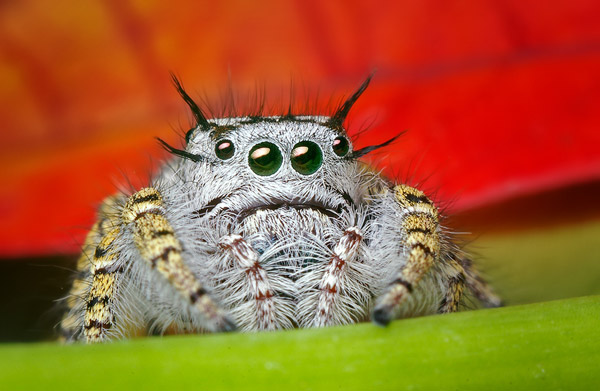
(Источник: )

(Источник: )
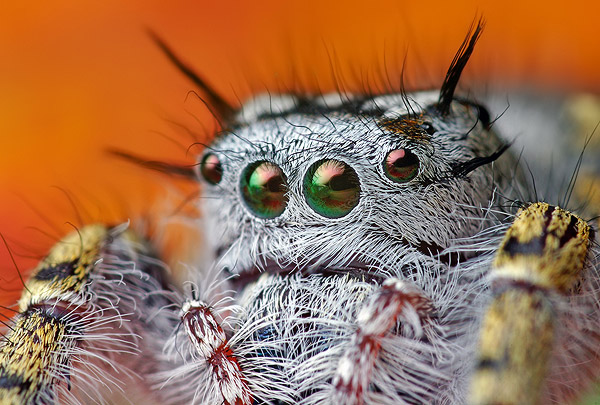
(Источник: )
Взрослая самка Phidippus audax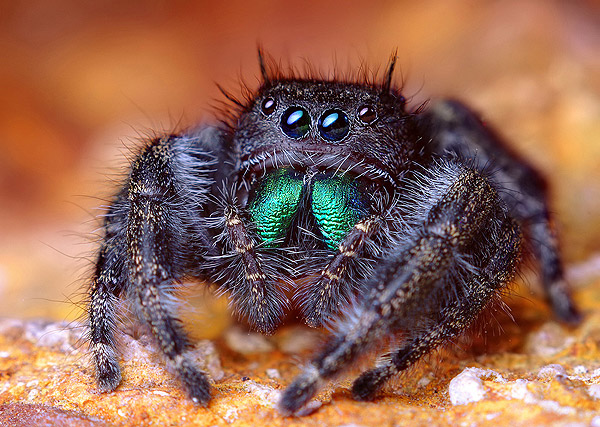
(Источник: )

(Источник: )
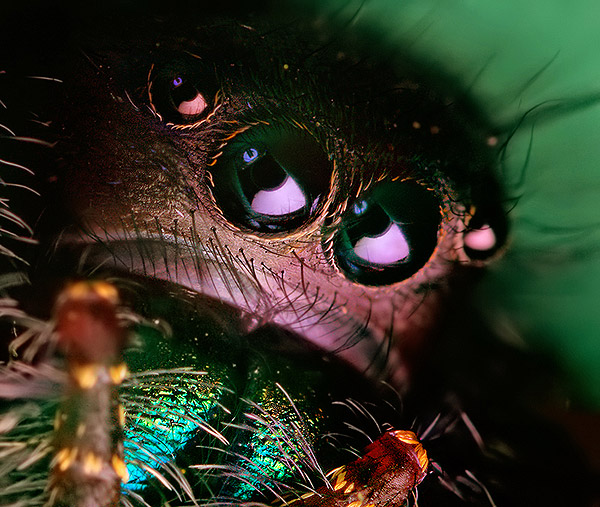
(Источник: )
Взрослая самка Phidippus clarus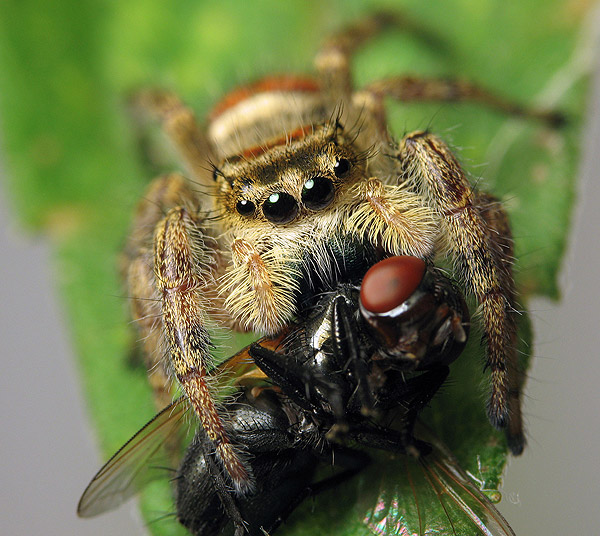
(Источник: )
Phidippus otiosus
(Источник: )
Взрослый самец Pelegrina pervaga
(Источник: )
Взрослый самец Habronattus coecatus прячется в листьях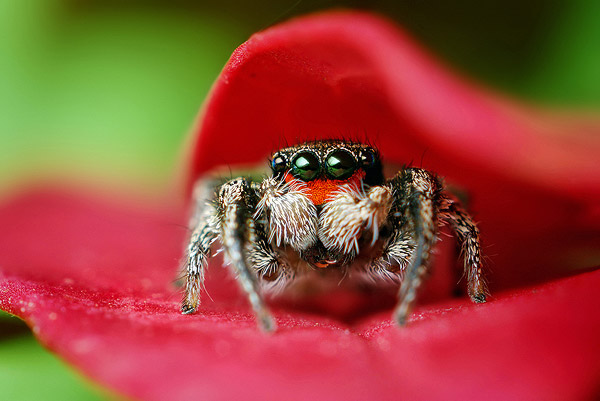
(Источник: )
Взрослый самец Hentzia palmarum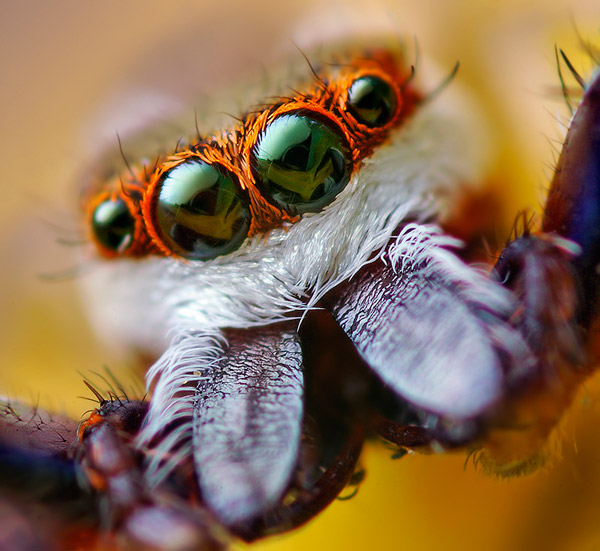
(Источник: )
Самец Pelegrina galathea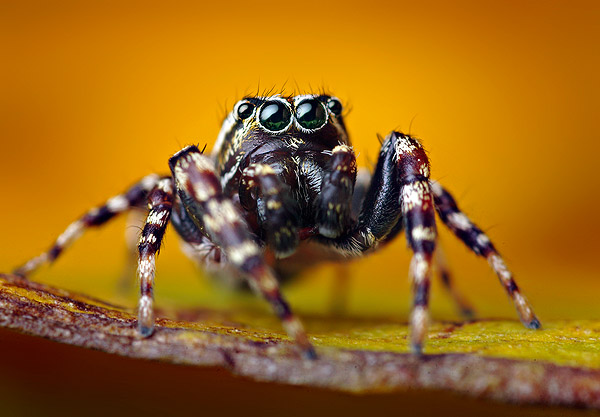
(Источник: )
Sitticus fasciger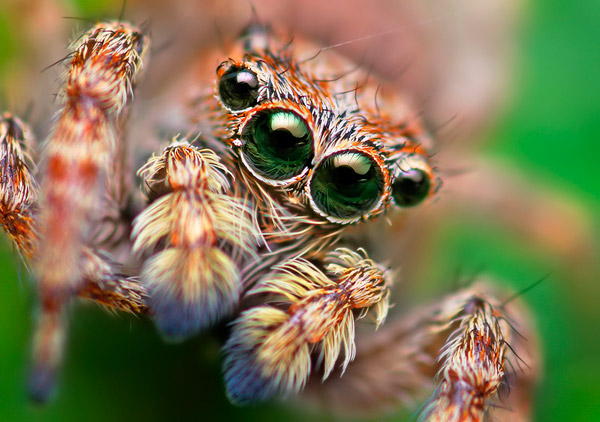
(Источник: )
المتابعون
أرشيف المدونة الإلكترونية
-
▼
2011
(358)
-
▼
أبريل
(15)
- Biggest Snakes
- snake king cobra-national geographic
- King Cobra Caught in Local's Yard in Thailand
- Thailand Monocled Cobras Close Up NOT at Show, in ...
- King Cobra Closeup
- zehirli yılanlar
- Learn something to Save Your Life
- copra
- عناكب
- عناكب
- اكتشف العلماء نوعا جديدا من العناكب مختبئة في الكث...
- اكبر العناكب حجما ويسمى عنكبوت أكل الطير
- عيون العناكب
- أخطر 10 ثعابين قاتلة في العالم
- الفيلم الوثائقي سادة الأفاعي - الكوبرا الملك Part2/5
-
▼
أبريل
(15)
